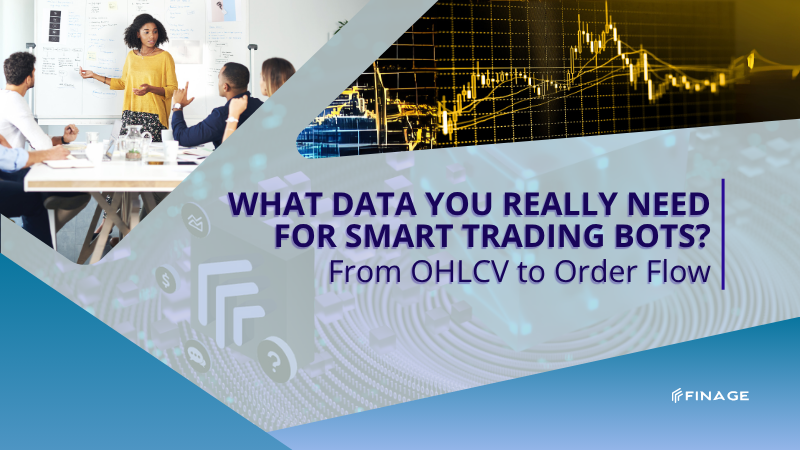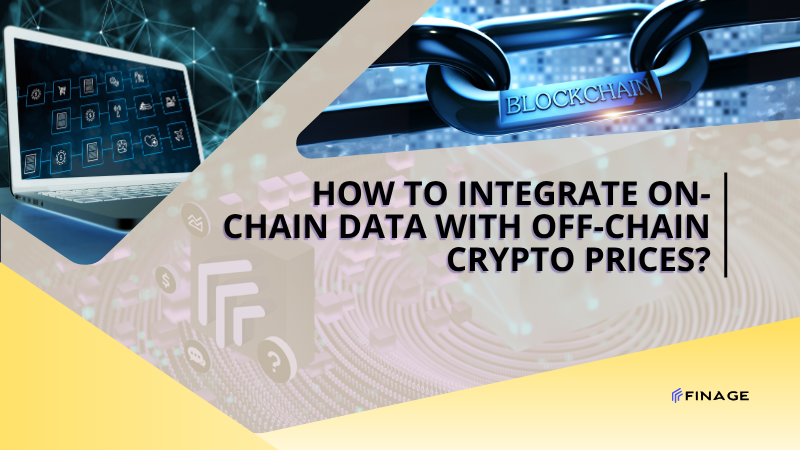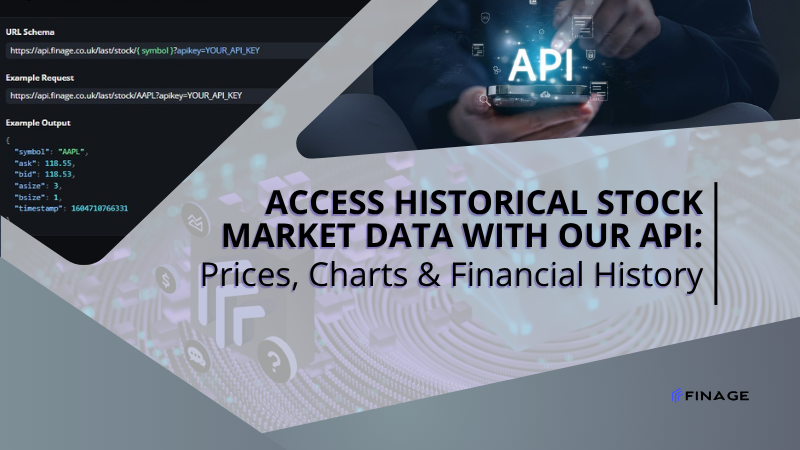From OHLCV to Order Flow: What Data You Really Need for Smart Trading Bots
6 min read • July 7, 2025

Introduction
Not all trading bots are created equal—and neither is the data they depend on. Whether you're automating a momentum strategy, a mean reversion system, or an arbitrage engine, the intelligence of your bot comes down to the quality and structure of the market data it consumes.
Basic bots often rely on OHLCV (Open, High, Low, Close, Volume) data. But as competition tightens and latency shrinks, smarter bots are moving deeper—into order book depth, trade flow, and real-time sentiment signals.
In this guide, we’ll walk through what data types are essential for building responsive, accurate, and competitive trading bots in 2025—and how APIs like Finage help deliver that data in real time.
Table of Contents
- Why Data Is the Brain of Your Trading Bot
- Understanding the Limits of OHLCV
- Going Deeper: Tick Data and Order Flow
- Real-Time Feeds vs. Snapshot APIs
- How Finage Powers Smart Bot Architectures
- Final Thoughts
1. Why Data Is the Brain of Your Trading Bot
Your trading bot is only as intelligent as the information it receives. Strategy, logic, and code structure matter—but without timely, accurate data, even the most sophisticated algorithms fall short.
Consider what your bot actually needs to do:
- Detect opportunities based on price movement or volume shifts
- React to sudden volatility or order book imbalances
- Avoid slippage or unfavorable entry points during fast market conditions
- Make decisions based on evolving market sentiment
To do any of this effectively, bots require not just any data—but the right data, delivered at the right speed, and in the right format.
That’s why choosing the right market data source is not just a technical decision—it’s a strategic one. And for developers building smarter bots in 2025, real-time precision is the new baseline.
2. Understanding the Limits of OHLCV
OHLCV data—open, high, low, close, and volume—is often the first dataset new developers use when building trading bots. It’s clean, easy to visualize, and works well with technical indicators. But on its own, it’s not enough for bots that need to compete in real time.
Why OHLCV Falls Short:
- Lagging Nature
OHLCV data is aggregated over intervals—minutes, hours, days—meaning your bot is reacting to what already happened, not what’s happening now.
- No Microstructure Insight
You don’t see how price moves within the candle. Two identical candles might represent very different intrabar activity (e.g., smooth trends vs. violent reversals).
- No Order Book Context
OHLCV tells you the final trade prices and volumes—but not what was sitting in the bid/ask at the time, or how deep the liquidity really was.
- No Trade Direction
Volume is shown in aggregate, with no indication of whether it came from aggressive buyers or sellers. This makes it hard to identify true momentum.
That’s not to say OHLCV is useless—far from it. It’s still valuable for building historical indicators, setting backtest parameters, and creating filters. But for entry timing, order management, and fast response, you need much more.
3. Going Deeper — Tick Data and Order Flow
To move beyond basic automation, your bot needs visibility into the microstructure of the market—what's happening tick by tick, not just bar by bar. That’s where tick data and order flow come into play.
Tick Data
This includes every individual trade as it occurs:
- Price and volume per trade
- Timestamp at millisecond (or microsecond) precision
- Directionality (buyer-initiated or seller-initiated)
With tick data, bots can spot patterns like burst trades, iceberg orders, or momentum clusters that would be invisible on aggregated charts.
Order Flow & Market Depth
Order flow data shows real-time bid and ask activity—essentially a live view of market intention. It allows bots to:
- Detect order book imbalances before price moves
- Respond to large limit orders (spoofing or genuine interest)
- Track liquidity gaps or sudden depth changes
Level 2 data (also known as market depth) exposes multiple price levels, enabling your bot to better estimate execution cost, predict slippage, and react proactively to shifts in supply/demand zones.
With a provider like Finage, you get both trade-level data and Level 2 order book snapshots, delivered via real-time WebSocket for immediate action.
4. Real-Time Feeds vs. Snapshot APIs
Not all APIs deliver data the same way. When building trading bots, how your data arrives is just as important as what the data contains.
Snapshot APIs
These REST endpoints return a full picture of the market at the moment you request it. They’re useful for:
- Backtesting or daily scanning
- Slow-moving strategies
- Lightweight mobile or web dashboards
But they fall short for bots needing real-time reaction. By the time your bot polls and processes a snapshot, the market may have moved.
Real-Time Streaming APIs
Streaming APIs (especially those using WebSockets) push updates to your bot as they happen—no polling required. This is essential when:
- Monitoring trade-by-trade action
- Tracking order book changes
- Reacting to fast-moving conditions
- Scaling to multiple markets simultaneously
For example, the Finage WebSocket API lets you subscribe to streaming tick data, Level 1 or Level 2 quotes, and receive it instantly in your application. That gives your bot the edge it needs to execute ahead of slower systems.
Speed isn't optional anymore—it’s structural.
5. How Finage Powers Smart Bot Architectures
If you’re building a trading bot that adapts, reacts, and executes in real time, your infrastructure decisions matter. That’s where Finage comes in—with a market data platform built specifically for fast, automated systems.
Here’s how Finage supports smart bot development:
- Unified Multi-Asset Coverage
Stream and query data from stocks, forex, crypto, and indices using a consistent API format. No need to juggle different providers or normalize feed structures.
- Real-Time WebSocket Feeds
The WebSocket API delivers trade ticks, quotes, and order book updates in real time—ideal for latency-sensitive bots and low-slippage execution.
- REST APIs for Strategy Calibration
Use historical OHLCV, tick history, and indicator-ready data to backtest strategies and calculate rolling metrics.
- Scalable, High-Throughput Infrastructure
Whether you’re running a single-pair bot or a multi-strategy engine across 100+ assets, Finage is built to support high-frequency operations with stable delivery.
- Developer-Centric Documentation
Finage Docs provide detailed guidance for every data type, helping you spend more time coding strategy and less time deciphering endpoints.
By combining real-time data speed with API simplicity, Finage lets you focus on logic—while it handles the complexity of market access.
6. Final Thoughts
Trading bots are no longer a novelty—they’re core infrastructure in fintech. But what separates the winners from the noise isn’t just code quality. It’s data awareness.
Relying on OHLCV alone is like driving with a rearview mirror. To compete, your bot needs to see the road ahead—in real time. That means streaming tick data, order book depth, and fast execution signals.
Finage gives you everything in one place—multi-asset support, real-time WebSockets, REST endpoints for historical calibration, and infrastructure that scales with your ambitions.
If you’re building for speed, scale, or smart execution, stop cobbling together feeds. Let Finage handle the market data layer so your strategy can do what it’s meant to: outperform.
Explore the Finage API suite and start powering your trading bots with the data they really need.
Claim Your Free API Key Today
Access stock, forex and crypto market data with a free API key—no credit card required.

Stay Informed, Stay Ahead
Finage Blog: Data-Driven Insights & Ideas
Discover company news, announcements, updates, guides and more


